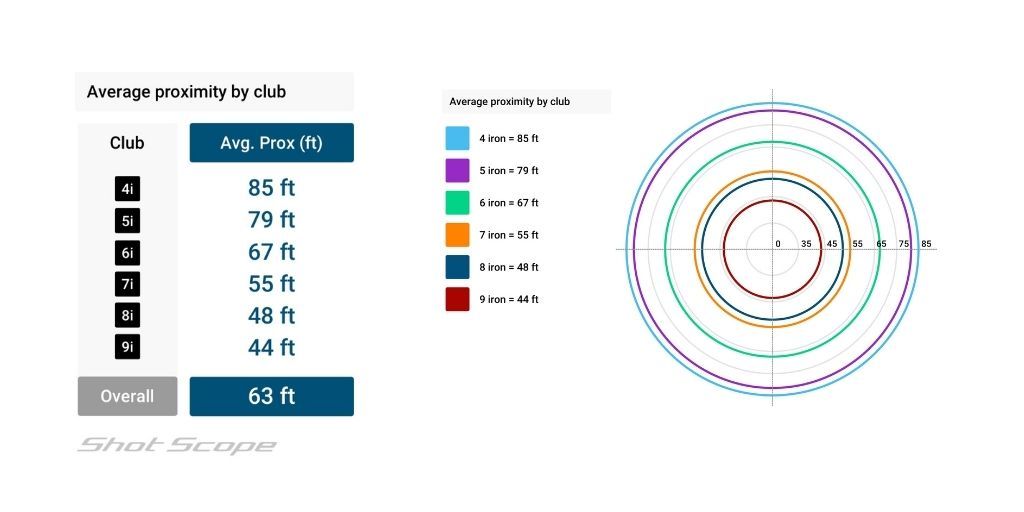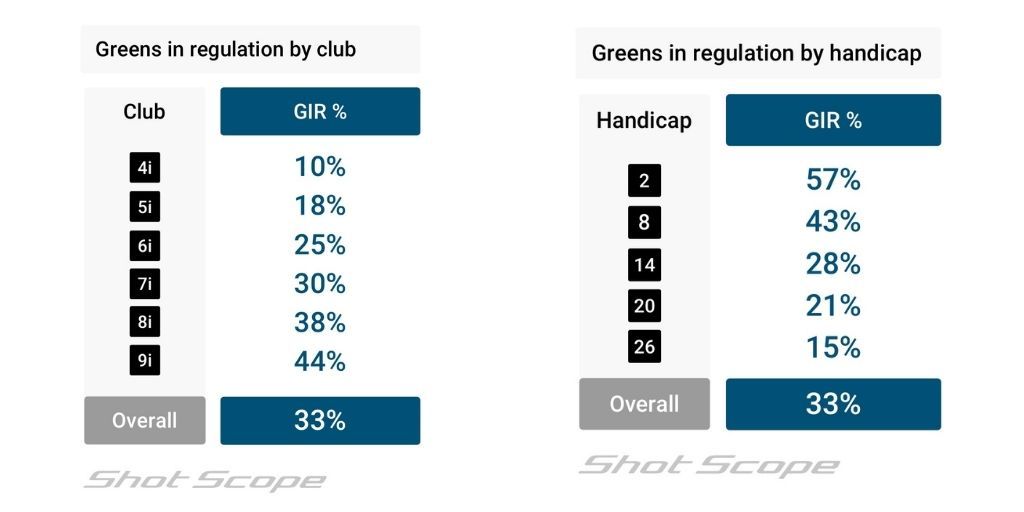
Approach shot strategy is one of my favorite topics to discuss. It's (mostly) easy to explain and can quickly lower a golfer's handicap if they change their habits.
In this article, and accompanying podcast, I'll explain the most common mistake most golfers make with their approach shot strategy and some simple changes you can make. I'll provide some statistics as well to make my case. For many of you, it might not be a topic you ever stopped to think about, but your default approach is likely costing you strokes. Let's get them back!
Approach Shots Are the Biggest Contributor to Scoring
For a long time, we didn’t quite understand why certain golfers scored better than others. Luckily, Mark Broadie, a professor at Columbia University, cleared that up for all of us. After researching millions of shots using his revolutionary strokes-gained statistics (a measurement of relative performance), he came to the following conclusion:
My analysis of millions of golf shots reveals a consistent finding: Approach shots account for the biggest scoring advantage between golfers of every skill level. The best golfers also gain strokes with their driving, short game and putting games, but approach shots are the greatest difference-maker.
As such, if you can improve your strategy with approach shots, you likely stand to gain larger jumps in scoring than any other part of the game.
In our latest podcast episode of The Sweet Spot, Adam Young and I take a deep dive into how to optimize your approach shot targets. I'll cover many of the concepts we discuss in this article, but I encourage you to listen to the entire episode here.
Why Aiming at the Pin is a Losing Strategy
Unfortunately, most golfers default to aiming at the pin with their approach shots. One of the great myths of golf is that you need to land the ball close to the pin and make birdie putts to lower your handicap. For the most part, choosing a more aggressive target like the pin results in more double bogeys, which is the real culprit of higher scores.
Allow me to build a case that will (hopefully) convince you to stop aiming at pins...
Nobody Has That Much Control of the Golf Ball
Several years ago, I wrote this article showing shot dispersions from different distances. Many people were surprised to see the results, and it's exactly why using launch monitors and game-tracking devices can be so powerful - you get a real understanding of your shot patterns.
The truth that every golfer needs to understand is that no player on this planet can land the ball close enough to the pin on average to make it a “profitable” strategy.
The following are average proximity to the pin from various distances by a typical PGA Tour player:
175 – 200 yards: 33 feet
150 – 175 yards: 28 feet
125 – 150 yards: 23 feet
100 – 125 yards: 19.5 feet
As you can see, they cannot land the ball that close to the pin from any distance.
From 100-yards to 110-yards in the fairway, PGA Tour Players hit 26% of their shots inside 10-feet.
The best players in the world hit one out of four inside 10-feet.
Your chances of doing better than that is 0.00%. #ManageYourExpectations— Lou Stagner (Golf Stat Pro) (@LouStagner) June 7, 2021
Now let's look at some proximity numbers from normal golfers with different clubs:

As you would expect, these are considerably larger.
Long story short, it's unreasonable to expect that anyone can keep the ball within a tight window of their target. You have to consider your overall shot patterns when selecting targets with approach shots.
Even If You Could Land It Close, You Can't Make the Putts
Perhaps the nail in the coffin for pin hunting is putting difficulty.
Let’s say you could outperform a PGA Tour player and land the ball 10 feet from the pin. Take a look at your odds of making putts from that distance:

Even if you could putt like a tour player, your odds are not very good.
In reality, it’s not likely you can land every ball within a 40-foot window of any pin on average with approach shots. And your odds of making those putts are quite minuscule. Sorry to burst your bubble!
It's Not About Birdies, Anyway
Now that you have a more rational understanding of how close you can actually land the ball to the pin and how difficult it is to make putts, I’ll make my last point.
Lowering your handicap is not about making birdies.
Please re-read that statement over and over again, and burn it into your memory. I wish I knew this when I first took up the game!
Perhaps one of the biggest myths about golf is that you need to make more birdies to lower your handicap. I’ve heard golfers tell me before that they average 5-6 birdies a round. I politely nod my head because I know they’re either lying to themselves or me.
PGA Tour players average between 2.5 to 5 birdies per round. A typical tour player will only make about 3.5 to 3.75 birdies per round. Many of those birdies are on par 5s, where they can get on most greens (or close to them) in two shots.
For regular golfers, birdies are more of a pipe dream. Here are birdies per round for different handicap levels:

The real path to a lower handicap is making fewer double bogeys, not making more birdies.
Now that we’ve cleared all that up, I can give you some basic guidelines on picking smarter targets with approach shots.
It's All About GIR
While most traditional golf statistics have been replaced by more informative, nuanced measurements like strokes gained, I still believe greens in regulation is a stat that golfers should focus on.
GIR is one of the greatest predictors of scoring success, and as you can see, it’s directly correlated with handicap levels.

If you want to play your best golf, your number one goal should be getting the ball on the putting surface with your approach shots, or at least leaving yourself a manageable wedge shot when you do miss the green.
In other words, this is a part of the game where a conservative strategy will lower your scores in the long run. The goal is to rack up boring pars, easy bogeys, and eliminate doubles (or worse). And yes, you can sprinkle a few birdies here and there.
Understanding Your Tendencies
In our podcast episode, Adam Young mentioned a powerful exercise that every golfer should go through with their approach shots. Adam states that he loves his players to measure their shot results relative to where they aimed.
Ultimately, the goal is to start distinguishing between bad shots and bad targets.
You keep track of your results manually or use a shot-tracking system like Shot Scope or even a launch monitor like SkyTrak (during your practice sessions).
Overall, this will help you figure out how to optimize your targets with approach shots. Often, players will notice that they miss many targets short, and by taking more club, they will hit more greens in regulation. Or you might realize that you have a left-bias miss and can use that data on the course.
Back and Middle Is a Good Idea
Several years ago, I wrote this article. It suggests that for most players, aiming at the center of the green, and using the yardage to the back of the green to plan your club selection, will lower most golfers’ scores in the long run.
Since then, I’ve received countless messages from readers who have seen significant reductions in their handicaps using this strategy. The reason is threefold:
- It simplifies the pre-shot process. When you know your target and yardage (use a GPS device for back yardage), you will be more committed to the shot.
- It is rare for golfers to “flush” their iron shots. Playing the back yardage allows for a mishit and still hitting the green in regulation. Also, the data is abundantly clear that almost every golfer misses 80-90% of their greens on the short site. It’s infrequent that golfers miss long most of the time.
- Aiming at the center of the green allows for the normal dispersion of your shot patterns from left to right. No matter what shot shape you play, you will still miss on both sides. As Boo Weekly said, “the center of the green never moves.” It’s a straightforward (and effective target) to default to on every hole.
Getting More Advanced
The back/center strategy will work very well for most golfers of a beginner or intermediate skill level. However, if you are a more advanced player, you can get more nuanced with your approach shot targets.
As I mentioned earlier, you can take your own shot distribution data and customize your targets.
Some general principles, like aiming away from big trouble, can help you adjust aim points on each hole. If you are looking for a systematic way to do this, I would strongly recommend taking a look at DECADE or DECADE Foundations.
This will require a little more planning ahead and thinking on the course. You have to be comfortable enough to take in a lot of information (yardage, slope, pin position, wind direction, areas surrounding green) and make decisions quickly. Because of this, I often only tell people to deviate from a more basic strategy if they have the skill level and time commitment to make it worth it.
Tying It All Together
I continually revisit approach shot strategy because I know this can transform many of your games. Additionally, it's a topic that is very easy to understand but requires a lot of discipline to stick with on the course. Therefore, I feel I need to remind all of you (and myself) of its importance.
To recap a few of the key concepts of the article and podcast:
- Approach shots have the most influence on scoring potential.
- Aiming at the pin all of the time is a bad idea. No golfer has the ability to land it close enough to their intended target to make it a profitable strategy.
- Lowering your handicap is more about limiting double bogeys than it is making birdies. This is why approach shot strategy is mostly about picking conservative, "boring" targets.
- For most golfers, aiming at the center of every green and playing the back yardage will lower scores over the long run.
- If you are a more advanced player, you can adopt a more nuanced, advanced approach-shot strategy. This takes into account the trouble surrounding the green and your tendencies as a ball striker.
My final plea is to be patient. Becoming a smart course manager means you are stacking odds in your favor over the long run. You'll be tempted to use short-term results as your measurement of success, but you have to look at your performance more broadly (think months, not weeks or singular rounds). I can guarantee lower scores if you follow some of this advice and commit to using it over the long haul.
We care about the protection of your data Read our Privacy Policy